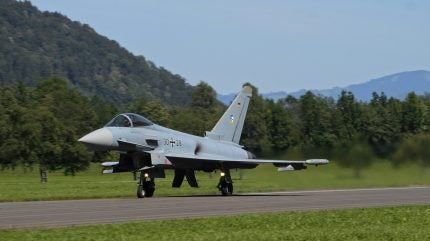
In a significant ILA Berlin Air Show announcement, German Chancellor Olaf Scholz revealed plans to purchase 20 additional Eurofighter jets, further solidifying Germany’s role in European defence and the aerospace industry.
This procurement, in addition to the 38 Eurofighters already on order, reflects Germany’s commitment to national security and industrial stability.
With a service life well beyond 2060, the new Tranche 4 Eurofighter is currently the most advanced combat aircraft built in Europe. According to GlobalData’s intelligence on the German defence market, between 2003 and 2021, Germany acquired 141 Eurofighter Typhoon multirole aircraft for its air force.
“By ordering these additional Eurofighters, we are not only reinforcing our defence capabilities but also providing essential support to Airbus and its extensive network of suppliers,” stated Chancellor Scholz. The move reveals the country’s commitment to Nato in response to the ongoing geopolitical instability following Russia’s invasion of Ukraine.
The Eurofighter Typhoon, a multirole fighter jet produced by a consortium of Airbus, BAE Systems, and Leonardo, will bolster Europe’s defence infrastructure. The expansion of Germany’s fleet is seen as a step in ensuring long-term security and operational readiness.
The new 20-aircraft contract has come alongside advancements in the Eurofighter Typhoon’s GPS defence capabilities. BAE Systems is continuing its Digital GPS Anti-jam Receiver into the next phase of the Phase 4 Enhancements programme.
Beyond the immediate defence implications, Scholz’s announcement highlights the Eurofighter programme’s economic significance. With a supply chain that employs more than 100,000 skilled workers across Europe, the Eurofighter project is part of the continent’s aerospace industry.
Eurofighter CEO Giancarlo Mezzanatto welcomed the news: “Today’s announcement from the German government is great news for the Eurofighter program and our industry partners. It underlines Germany’s long-term commitment to the Eurofighter and ensures the sustained technological advancement of the entire European region.”
The decision to enhance the fleet also reflects a broader strategy to maintain and expand arms production capacity within Germany. As global threats evolve, the need for defence technology becomes increasingly critical. The Eurofighter Typhoon, with its twin-engine, canard-delta wing design, can perform a range of missions from air to ground attack.
This announcement comes at a crucial time for the European defence sector. Integrating new Eurofighters into Germany’s military arsenal will enhance its defensive posture and reaffirm its leadership within Nato. Furthermore, the procurement ensures a steady flow of contracts and work for the high-tech manufacturing industry across Europe, fostering economic growth.
In a separate recent development in the German defence industry, Germany performed the keel-laying ceremony of the frigate “Niedersachsen,” marking the beginning of construction on the first vessel of the F126 class at the Peene shipyard in Wolgast.
As Germany prepares to place its order before the end of the legislative session in autumn 2025, the decision marks a clear signal of its priorities. By investing in defence capabilities and supporting the aerospace sector, Germany is taking a proactive stance in securing its national interests and contributing to the collective security of Europe.




